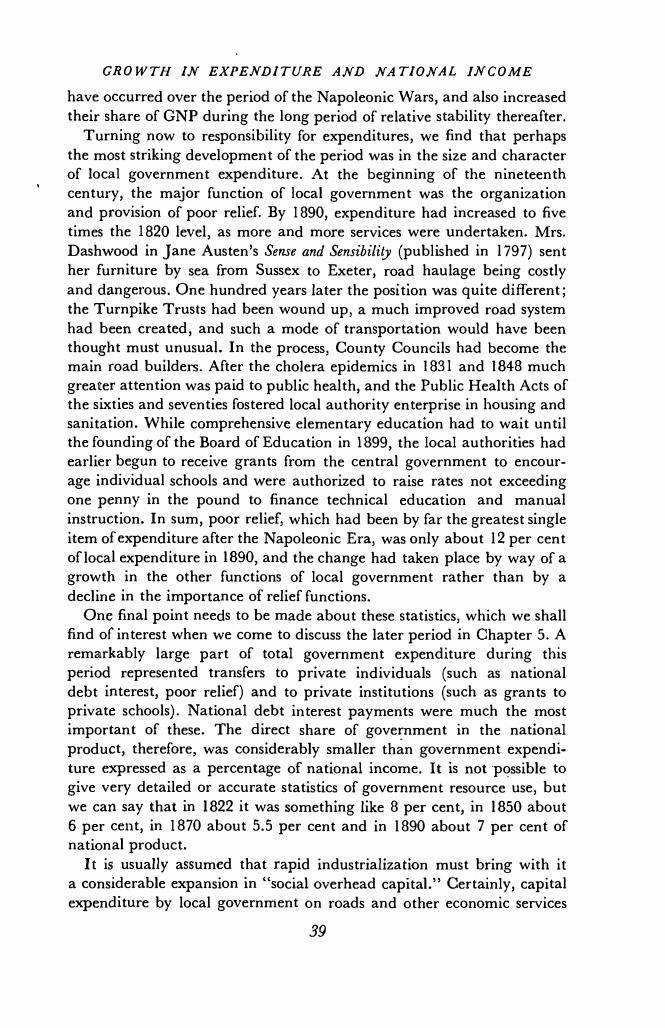正在加载图片...

growth in ExPENDITURE AND NATIONAL INCOME have occurred over the period of the Napoleonic Wars,and also increased their share of GNP during the long period of relative stability thereafter Turning now to responsibility for expenditures,we find that perhaps the most striking development of the period was in the size and character of local government expenditure.At the beginning of the nineteenth century,the major function of local government was the organization and provision of poor relief.By 1890,expenditure had increased to five es the 1820 level as mor and m Mrs Dashwood in Jane Austen's Sense and Sensibilily (published in 1797)sent her furniture by sea from Sussex to Exeter.road haulage being costly and dangerous.One hundred years later the position was quite different; the Turnpike Trusts had been wound up,a much improved road system had bee create and such a mode of transp would have b ought i sual.In the process,County Counci 6 come th main road builders.After the cholera epidemics in 1831 and 1848 much greater attention was paid to public health,and the Public Health Acts of the sixties and seventies fostered local authority enterprise in housing and sanitation.While comprehensive elementary education had to wait until the founding of the Bo ard of Edu ation in 1899,the local authorities had earlie to receive grants from th central government to encour age individual schools and were authorized to raise rates not exceeding one penny in the pound to finance technical education and manual instruction.In sum,poor relief,which had been by far the greatest single item of expenditure after the Napoleonic Era,was only about 12 per cent of local exp re in 1890, change had taker e b growth in the other functions way of a of local government rather than by a decline in the importance of relief functions. One final point needs to be made about these statistics,which we shall find of interest when we come to discuss the later period in Chapter 5.A remarkably large of total nditure during this repre nted parr g to privat as nationa debt interest,poor relief)and to private institutions (such as grants to private schools).National debt interest payments were much the most important of these.The direct share of government in the national product,therefore,was considerably smaller than govement expendi pe age of r nal income. It is not possible to give very detailed curate statistics of government reso urce use,bu we can say that in 1822 it was something like 8 per cent,in 1850 about 6 per cent,in 1870 about 5.5 per cent and in 1890 about 7 per cent of national product. It is usually assumed that rapid industrialization must bring with it a considerable expansion in"s cial overhead capital.Certainly,capital expenditure by local government on roads and other economic servicesGROWTH IN EXPENDITURE AND NATiONAL INCOME have occurred over the period of the Napoleonic Wars, and also increased their share of GNP during the long period of relative stability thereafter. Turning now to responsibility for expenditures, we find that perhaps the most striking development of the period was in the size and character of local government expenditure. At the beginning of the nineteenth century, the major function of local government was the organization and provision of poor relief. By 1890, expenditure had increased to five times the 1820 level, as more and more services were undertaken. Mrs. Dashwood in Jane Austen's Sense and Sensibility (published in 1797) sent her furniture by sea from Sussex to Exeter, road haulage being costly and dangerous. One hundred years later the position was quite different; the Turnpike Trusts had been wound up, a much improved road system had been created, and such a mode of transportation would have been thought must unusual. In the process, County Councils had become the main road builders. After the cholera epidemics in 1831 and 1848 much greater attention was paid to public health, and the Public Health Acts of the sixties and seventies fostered local authority enterprise in housing and sanitation. While comprehensive elementary education had to wait until the founding of the Board of Education in 1899, the local authorities had earlier begun to receive grants from the central government to encourage individual schools and were authorized to raise rates not exceeding one penny in the pound to finance technical education and manual instruction. In sum, poor relief, which had been by far the greatest single item of expenditure after the Napoleonic Era, was only about 12 per cent of local expenditure in 1890, and the change had taken place by way of a growth in the other functions of local government rather than by a decline in the importance of relief functions. One final point needs to be made about these statistics, which we shall find of interest when we come to discuss the later period in Chapter 5. A remarkably large part of total government expenditure during this period represented transfers to private individuals (such as national debt interest, poor relief) and to private institutions (such as grants to private schools). National debt interest payments were much the most important of these. The direct share of government in the national product, therefore, was considerably smaller than government expenditure expressed as a percentage of national income. It is not possible to give very detailed or accurate statistics of government resource use, but we can say that in 1822 it was something like 8 per cent, in 1850 about 6 per cent, in 1870 about 5.5 per cent and in 1890 about 7 per cent of national product. It is usually assumed that rapid industrialization must bring with it a considerable expansion in "social overhead capital." Certainly, capital expenditure by local government on roads and other economic services 39